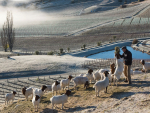Dr Richard Smart: Celebrating the legacy of the "world’s best-known viticulturist"
Dr Richard Smart spent more than 55 years advising students, growers and organisations around the world on vine physiology and canopy management.
Mark Allen is well known for shaking the proverbial tree when it comes to getting vine research into vineyard action.
And foremost among his passion projects is the literal shaking of vines for botrytis control. "To me it was such a breakthrough it needed to be in front of growers all of the time," he says, 15 years after trials revealed that fruit thining with shaking had a serendipitous second function of reducing botrytis in Sauvignon Blanc by 55%.
Mechanical shaking, subsurface irrigation and long spur pruning are examples of wine research that makes perfect sense for growers, says Mark, one of the 2025 New Zealand Winegrowers Fellows, recognised for his unrelenting services to research and extension. "If we keep innovating, we can continue to succeed."
His path to the wine industry began when he left a farm in the United Kingdom's Cotswolds in 1967, travelling to Australia to work a year with a group of UK farmers developing the wheat belt north of Perth. Mark then moved to New Zealand, where he had relatives, with a plan to do an agricultural degree at Lincoln University. He'd had his first year of prerequisite experience in Australia and did the second at the 'number 1 dairy unit' at Ruakura. But Mark was increasingly intrigued by growing plants rather than stock, and in 1969 took on work experience at a 'Chinese gooseberry' orchard in the Bay of Plenty, at the very beginning of what would become the kiwifruit boom. "I started liking it so much I bought the orchard and never got to Lincoln."
He'd meanwhile married a New Zealander, and they'd spent the next 15 years helping pioneer the industry, riding its growing success until it collapsed in the mid-1980s. Mark recalls the year he did not get paid for his crop, comparing it to grape growers who could not sell fruit in the 2025 harvest. "Kiwifruit went through a far worse downturn really, but there's been an amazing recovery," he says, applauding that industry for its huge investment in research and development.
The downturn saw the Allens sell up, and his next move was helping his friend (and former kiwifruit grower) Morton Brown, founder of Morton Estate, find suitable blocks for vineyards in Hawke’s Bay and Marlborough. Mark says he had always had an interest in wine (he still has the notes and clear flavour memories from a wine tasting class at his high school) and the move from kiwifruit to grapes was not a great leap.
He set off with his spade and a collection of “magnificent” DSIR soil maps, which he still cherishes – “they were done in the depression years, and accurate to the metre” – and within three months had found nearly 300 hectares of suitable land, priced at $7,000 per hectare in Marlborough, and hundreds per hectare for elevated terraces with sandy loam in Hawke’s Bay. The developments came in the wake of the government vine pull, and it was a “wonderful period” planting predominantly Chardonnay, but also Pinot Noir and some Bordeaux varieties in Hawke’s Bay. “That was a great time – Dr Richard Smart (page 40) was such a huge influence on us all. I was completely inspired by him and his thinking.”
After 18 years with Morton Estate, Mark was approached by Villa Maria in 2002 and became National Vineyards Manager, followed by a role with Sacred Hill. He enjoyed the work, but after spending a lot of his weeks in Marlborough, where he received myriad requests for independent advice, he set up his own company, Mark Allen Vineyard Advisory Services Limited, and the Allens moved to Marlborough.
While running his consultancy, Mark also project managed a three-year trial, from 2011-2014, on ‘Mechanical Shaking for Botrytis Control’, funded by the Ministry for Primary Industries and NZW, and conducted by Plant & Food Research Marlborough. The project was extended in 2017, and Mark continues to work hard to convince grape growers of its merits, helping with fact sheets, popular articles, videos and other extension programmes, including speaking at grower events like Grape Days.
He’s also regularly asked for guidance on long spur pruning, subsurface irrigation and trunk disease. He is increasingly seeing 25- to 30-year-old vineyards in Marlborough reaching the end of their profitable life and in some cases becoming a liability. With a cost of about $100,000 per hectare to replace a vineyard, it’s not an easy decision for growers, given the increasing cost of production and declining demand and grape price.
Mark is still doing grower workshops every year, working with Bragato Research Institute on extension, advising clients, and promoting the benefits of his passion projects. It’s incredible to have witnessed the good luck of events like mechanical shaking being revealed as a botrytis weapon, or the chance combination of soil, climate and variety that saw Marlborough become a Sauvignon Blanc benchmark for the global wine industry, he says. “We come across these things serendipitously and we should be holding onto them like nothing on earth.”

The end of the year is fast approaching, so here are some thoughts on a few of the significant developments…

OPINION: When I moved to Marlborough two decades ago, I found countless lines of tidy vines, neatly mowed and carefully…
The large 2025 harvest will exacerbate the wine industry's "lingering" supply from recent vintages, New Zealand Winegrowers Chief Executive Philip…
If you find a new consumer in a developed wine market, you are taking them from someone else, says Blank…
OPINION: Sauvignon Blanc was famously introduced to New Zealand by Ross Spence of Matua Valley, and then serendipitously planted in…